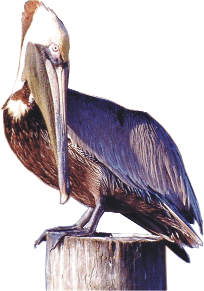 |
Page 2 |
 |
Page 2 |
We entered the Everglades Park
at 11:00 a.m. on the 15th and stopped at some of the more northern attractions
near the Park's entrance. We were rewarded with lots of photo opportunities.
We arrived at Flamingo at 2:00 p.m. and settled down in the Flamingo Lodge.
We had called weeks ahead of time, to reserve a room, a necessary precaution
as the Lodge fills up most days. We used the afternoon of the 15th
and the morning of the 16th to rest up, investigate the park, talk to sailors,
fishermen, campers, birders, sightseers, and get the boat in order.
Flamingo is an ideal starting point for waterborne adventures. There
is a dam at the Flamingo marina that separates the salt water of the Bay
of Florida from the brackish water of the Whitewater Bay to the north.
Boats can put in on either side of the dam. Putting in on the south
side leads you into Florida Bay and among the Florida Keys. Putting
in on the other side gets you, via a canal, to Whitewater Bay and the wilderness
waterway. While you make up your mind, you can swim in the Lodge's
pool, have dinner at the ranger station's restaurant, and enjoy some simple
nighttime entertainment at the bar.

Cormorant |

Osprey |
| The wilderness waterway, was our choice. The Park Service has laid out an 80 mile route from Flamingo to Everglades City that threads through more than 30 different canals, creeks, rivers, and bays. Piloting over the route is made possible by a series of special markers. Three NOAA nautical charts show the markers and provide sufficient detail to allow for limitless side trips. The markers are small and occasionally there is the possibility of making a wrong turn; this gets your attention and is part of the waterway's challenge. For canoeists, a wrong turn can mean back-tracking against a strong wind. After the swearing is over the canoeist generally will reach for a compass and binoculars, and from then on, will start every leg of the route with a compass reading and careful sightings for the markers. Getting lost or making slow progress presents another challenge for the canoeist - that is, not making the appointed camping location before nightfall. For canoeists, camping is limited mostly to "chickees." The Park Service has built nearly thirty such "chickees" - raised platforms, each having a covered picnic table, a place for a tent, and a pit toilet. We stopped at several of these to stretch our legs and found them in good condition. Canoeists will have to schedule each of their overnight stays with the rangers ahead of time - hence, the need to reach the appointed campsite every night. Lucky for the sailboater we didn't have to worry about such things as we sleep aboard and can anchor anywhere. |

Anhinga |

Little Blue Heron |